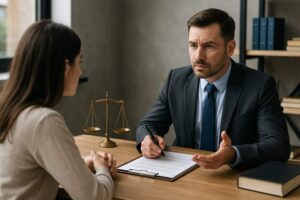If you slip and fall as a result of dangerous property condition and become injured, you could have a personal injury lawsuit. An injured party could file a suit if a spill or lack of maintenance caused conditions to be unsafe. It can also happen for a wide variety of other reasons. The owner of the property could be liable for some or all of the compensation for your injuries, pain, and suffering.
Statute of Limitations for Slip and Fall Cases
The statute of limitations is the amount of time following a slip and fall accident you have to file a lawsuit. In the State of Florida, the statute of limitations for a personal injury case is 4 years. However, it is recommended that suits be filed much earlier, as sometimes litigation will lead to finding different culpable parties.
Awards for Damages
There are two variables that help to determine the amount of a personal injury lawsuit. They are the degree of the injury and the liability of the defendant. The degree of the injury is the most obvious part of the lawsuit, as the purpose of the lawsuit is to compensate for damages. This means medical bills, future predicted medical bills, loss of work, pain and suffering.
Degree of Injury
An example of awards for damages based on degree of injury is a Tallahassee case in 2019 stemming from a fall in 2016. The plaintiff sustained multiple injuries after slipping on water leaking from an ice bin in a convenience store. In this case, the woman needed multiple surgeries and physical therapy. Her medical bills totaled $111,000. Doctors expected future medical bills to be around $350,000. The court awarded her 1.9 million dollars due to her permanent damage and lifelong pain she will suffer. It is one of the biggest verdicts ever for that area of the state.
Liability of the Defendant
Just because someone falls, that alone does not mean the premise owner is responsible. A plaintiff still needs to prove the premise owner did something wrong. What is referred to as liability, or fault. Proving liability/ fault can be very difficult, we recommend if you do suffer a fall, try and take pictures of the area. Pictures can greatly assist us in determining what the premise owner did wrong.

Premises Liability
Property owners are required to warn people about potential danger on the property. This is why you see signs about wet floors and orange cones around sidewalk construction. The challenge in a premises liability slip and fall case is proving that the accident occurred because of the defendant’s negligence. As previously indicated, for this reason if you do fall, take pictures of the area. Note, defendants often use security cameras and other recording devices as forms of evidence. Generally speaking, the Defendant will not provide this evidence until a lawsuit is filed. So it is very important to have our own evidence of what caused the fall. If you fall, take pictures. Also, be aware, Defendants will use social media to try and say your claim is exaggerated.
Constructive Notice
In many cases, the courts award damages because the Defendant knew about the hazards of the property and did nothing to prevent injuries to people on the property. In the Tallahassee case, the ice bins had caused a previous fall. The property owner knew about the hazard but did not have any warnings for patrons. However, a South Florida case against a bowling alley happened when a girl slipped on water spilled in an arcade room. The property owners and employees stated they did not know the water was there. This plaintiff won because of constructive notice.
Constructive notice is the idea that the defendant should know about conditions on the property. The bowling alley had not followed through with their own mandated inspections. Had they done their inspections, they would have known about the spillage. Property owners can be held liable through the theory of constructive notice, even when they have no knowledge of any hazards. This occurs because of a reasonable expectation by others that they should know. It is reasonable to expect that a floor in an arcade room will be dry. The plaintiff shouldn’t have needed to exercise additional caution.
Contributive Negligence
A plaintiff’s contributive negligence often plays a part in slip and fall cases because it is often both parties fault that an accident happened. For example, if an you can clearly see an object, yet you trip on it, it is not the property owner’s fault alone that the accident happened. Florida law holds the expectation that every person is responsible to make efforts to keep themselves safe. Choice of shoe wear, the decision to talk on the phone while walking, and many other benign decisions can make the courts hold you partially responsible for your own injuries. This is contributive negligence.
A jury decides how much to hold you responsible for your slip and fall. The court adjusts the verdicts accordingly. If you were half responsible, and your verdict based on injury is $50,000, then this would be reduced $25,000 based on contributive negligence. This decision creates fairness in the judicial process. It is much better than dismissing cases where the plaintiff is partially responsible.
Your Injuries Deserve Compensation
The injuries sustained in a slip and fall accident are not something to sweep under the rug and not hold property owners liable for unsafe conditions. Many slip and fall cases include loss of income from missing work, lengthy medical care, and permanent pain and suffering. Lawsuits can compensate you for your losses. They also motivate property owners to maintain their properties, so accidents do not happen. There are two results of personal injury claims. One is to attempt to make you “whole” again. The other is to prevent the recurrence of accidents caused by property owner negligence.



